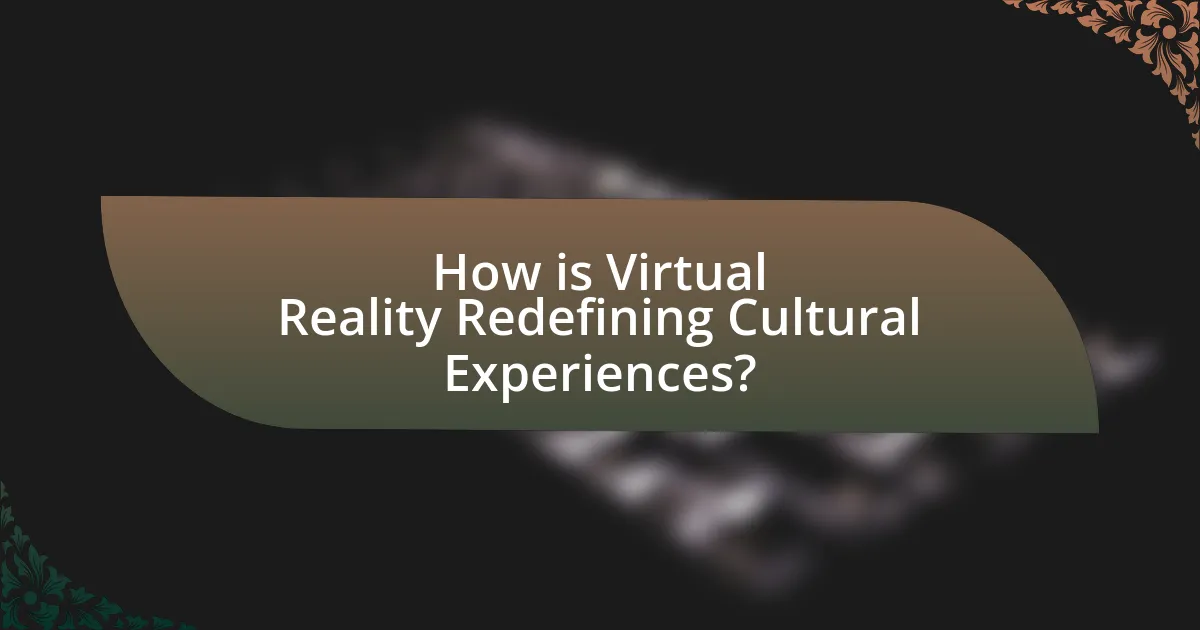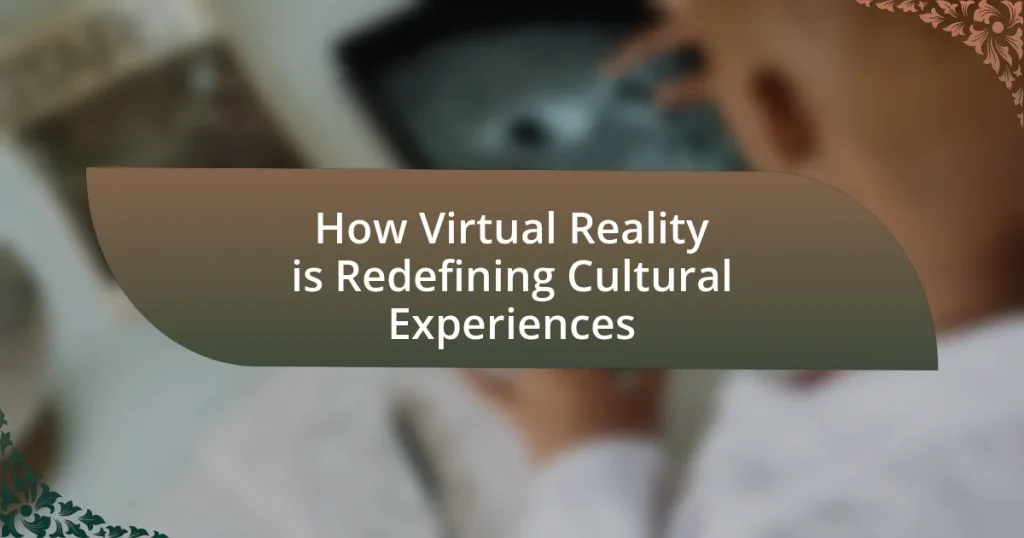Virtual Reality (VR) is transforming cultural experiences by providing immersive interactions with art, history, and diverse cultures. Key features of VR in cultural contexts include immersive experiences, interactive storytelling, and enhanced accessibility to cultural artifacts. The technology fosters empathy and understanding of different cultures, while also playing a crucial role in cultural preservation and documentation of endangered cultures. Challenges such as accessibility, cultural sensitivity, and technological limitations must be addressed to maximize VR’s potential in cultural applications. Future trends indicate a growing integration of AI and enhanced interactivity, promising to further enrich cultural engagement through VR.

How is Virtual Reality Redefining Cultural Experiences?
Virtual Reality (VR) is redefining cultural experiences by enabling immersive interactions with art, history, and diverse cultures. Through VR technology, users can explore virtual museums, attend live performances, and participate in cultural rituals from anywhere in the world. For instance, the VR experience “The Night Cafe” allows users to step inside Vincent van Gogh’s paintings, providing a unique perspective on his work. Additionally, studies show that VR can enhance empathy and understanding of different cultures, as evidenced by projects like “The 360-Degree Project,” which immerses users in the lives of individuals from various backgrounds. This transformative approach not only democratizes access to cultural experiences but also fosters a deeper appreciation for global diversity.
What are the key features of Virtual Reality in cultural contexts?
The key features of Virtual Reality in cultural contexts include immersive experiences, interactive storytelling, and accessibility to diverse cultural artifacts. Immersive experiences allow users to engage with cultural environments in a lifelike manner, enhancing emotional connections and understanding. Interactive storytelling enables users to participate in narratives, making cultural education more engaging and personalized. Accessibility is improved as Virtual Reality can bring remote or endangered cultural sites to a global audience, allowing for virtual visits that would otherwise be impossible. For instance, projects like Google Arts & Culture have utilized Virtual Reality to provide virtual tours of museums and historical sites, demonstrating its effectiveness in cultural preservation and education.
How does immersion enhance cultural understanding in Virtual Reality?
Immersion in Virtual Reality enhances cultural understanding by allowing users to experience and interact with diverse cultures in a simulated environment. This experiential learning fosters empathy and deeper connections, as users can engage with cultural practices, traditions, and social interactions firsthand. Research indicates that immersive experiences can lead to increased cultural sensitivity and awareness, as participants are more likely to retain information and reflect on their experiences compared to traditional learning methods. For instance, a study by Slater et al. (2013) demonstrated that participants who engaged in immersive VR experiences showed greater understanding and appreciation of different cultural contexts, highlighting the effectiveness of immersion in promoting cultural understanding.
What role does interactivity play in Virtual Reality cultural experiences?
Interactivity is crucial in Virtual Reality cultural experiences as it enhances user engagement and immersion. By allowing users to actively participate in the environment, interactivity transforms passive observation into an active exploration of cultural narratives. For instance, studies have shown that users who engage with interactive elements in VR environments report higher levels of emotional connection and retention of cultural information compared to traditional media formats. This is evidenced by research conducted by the University of Southern California, which found that interactive VR experiences can increase empathy and understanding of diverse cultures, thereby enriching the overall cultural experience.
Why is Virtual Reality important for cultural preservation?
Virtual Reality (VR) is important for cultural preservation because it enables immersive experiences that can replicate and showcase cultural heritage in ways traditional methods cannot. By creating virtual environments, VR allows users to explore historical sites, artifacts, and cultural practices that may be endangered or inaccessible due to physical, political, or economic barriers. For instance, UNESCO has recognized VR’s potential in projects like the “Digital Preservation of Cultural Heritage,” which aims to digitally document and recreate sites at risk of destruction, such as the ancient city of Palmyra in Syria. This technology not only aids in the documentation and education of cultural practices but also fosters global awareness and appreciation, ensuring that diverse cultures are preserved for future generations.
How can Virtual Reality help in documenting endangered cultures?
Virtual Reality (VR) can significantly aid in documenting endangered cultures by providing immersive experiences that capture and preserve cultural practices, languages, and environments. VR technology allows users to engage with cultural artifacts and rituals in a three-dimensional space, facilitating a deeper understanding and appreciation of these cultures. For instance, projects like “The Virtual Reality Museum of Canada” have successfully recreated Indigenous cultural sites, enabling users to explore and learn about traditions that are at risk of being lost. This immersive documentation not only serves as a record for future generations but also raises awareness and fosters empathy among a global audience, thereby contributing to cultural preservation efforts.
What are the implications of Virtual Reality for historical reenactments?
Virtual Reality (VR) significantly enhances historical reenactments by providing immersive experiences that allow participants to engage with history in a more interactive and realistic manner. This technology enables users to experience historical events and environments firsthand, fostering a deeper understanding of cultural contexts and historical narratives. For instance, VR applications can recreate specific battles or daily life in different eras, allowing users to visualize and interact with historical figures and settings. Studies have shown that immersive experiences can improve retention of historical knowledge, as participants are more likely to remember information when they actively engage with it rather than passively observing. Furthermore, VR can democratize access to historical education, allowing individuals who may not be able to visit historical sites to experience them virtually, thus broadening the audience for historical education and appreciation.
What challenges does Virtual Reality face in cultural applications?
Virtual Reality faces several challenges in cultural applications, primarily including accessibility, cultural sensitivity, and technological limitations. Accessibility issues arise from the high cost of VR equipment, which can limit participation from diverse socioeconomic backgrounds. Cultural sensitivity is crucial, as misrepresentation or appropriation of cultural elements can lead to backlash and alienation of communities. Additionally, technological limitations, such as the need for high-quality graphics and immersive experiences, can hinder the effectiveness of VR in accurately representing cultural narratives. These challenges must be addressed to ensure that VR can serve as a meaningful tool for cultural engagement and education.
How do technological limitations affect the quality of cultural experiences?
Technological limitations significantly diminish the quality of cultural experiences by restricting the immersive and interactive potential of virtual reality. For instance, inadequate hardware can lead to lower resolution graphics, resulting in a less engaging visual experience that fails to capture the intricacies of cultural artifacts. Additionally, limited processing power can hinder real-time interactions, making it difficult for users to fully engage with the cultural content. Research indicates that experiences rendered in high fidelity, such as those achieved with advanced VR technology, enhance emotional connection and retention of cultural knowledge, as evidenced by studies showing that participants in high-quality VR environments report higher satisfaction and engagement levels compared to those in lower-quality settings.
What ethical considerations arise from using Virtual Reality in cultural contexts?
Using Virtual Reality in cultural contexts raises several ethical considerations, primarily concerning cultural appropriation, representation, and consent. Cultural appropriation occurs when VR experiences exploit cultural elements without proper acknowledgment or respect, potentially leading to misrepresentation and commodification of cultural practices. Representation is critical, as VR can perpetuate stereotypes or inaccuracies about cultures, impacting how they are perceived by users. Additionally, obtaining informed consent from individuals whose cultural practices are being represented in VR is essential to ensure respect and authenticity. These ethical considerations highlight the need for sensitivity and responsibility in the development and deployment of VR technologies within diverse cultural settings.
How can Virtual Reality enhance accessibility to cultural experiences?
Virtual Reality enhances accessibility to cultural experiences by allowing individuals to engage with art, history, and heritage from remote locations. This technology enables immersive experiences that can be tailored to accommodate various disabilities, such as visual or mobility impairments. For instance, virtual museum tours can provide audio descriptions and interactive elements that make cultural content accessible to a broader audience. According to a study by the University of Southern California, VR experiences can increase engagement and understanding of cultural artifacts by 30% compared to traditional methods. This demonstrates that Virtual Reality not only democratizes access to cultural experiences but also enriches the way individuals interact with and learn about diverse cultures.
What are the future trends of Virtual Reality in cultural experiences?
Future trends of Virtual Reality (VR) in cultural experiences include increased accessibility, enhanced interactivity, and the integration of artificial intelligence. Accessibility will improve as VR technology becomes more affordable and widespread, allowing diverse audiences to engage with cultural content from anywhere. Enhanced interactivity will allow users to participate in immersive storytelling, enabling them to influence narratives and explore environments in real-time. The integration of artificial intelligence will personalize experiences, adapting content to individual preferences and learning styles. These trends are supported by the growing adoption of VR in museums and cultural institutions, which reported a 30% increase in visitor engagement through VR exhibits in recent years.
How might advancements in technology shape the future of cultural engagement?
Advancements in technology, particularly through virtual reality, will significantly shape the future of cultural engagement by providing immersive experiences that enhance interaction with cultural content. Virtual reality allows users to experience art, history, and performances in a three-dimensional space, fostering deeper emotional connections and understanding. For instance, studies have shown that virtual reality experiences can increase empathy and engagement, as evidenced by projects like “The Night Cafe,” which recreates Vincent van Gogh’s famous painting in a fully interactive environment. This technology not only democratizes access to cultural experiences but also enables remote participation, allowing individuals from diverse backgrounds to engage with cultural heritage in ways previously unimaginable.
What potential collaborations could emerge between cultural institutions and VR developers?
Cultural institutions and VR developers could collaborate to create immersive exhibitions that enhance visitor engagement. For instance, museums could partner with VR developers to design virtual tours that allow users to explore historical sites or artworks in a 3D environment, thereby expanding access to cultural heritage. A notable example is the collaboration between the British Museum and VR companies to develop virtual reality experiences that recreate ancient civilizations, making history more accessible and engaging for a global audience. Such partnerships can also lead to educational programs that utilize VR technology to teach art and history in innovative ways, fostering a deeper understanding of cultural contexts.
What practical tips can enhance the use of Virtual Reality in cultural experiences?
To enhance the use of Virtual Reality in cultural experiences, it is essential to focus on immersive storytelling, user-friendly interfaces, and high-quality content. Immersive storytelling engages users by creating narratives that resonate with cultural themes, allowing participants to feel a deeper connection to the experience. User-friendly interfaces ensure accessibility for diverse audiences, enabling seamless navigation and interaction within the virtual environment. High-quality content, including realistic graphics and authentic cultural representations, enhances the overall experience, making it more engaging and educational. Research indicates that immersive experiences can increase retention of cultural knowledge by up to 70%, demonstrating the effectiveness of these practical tips in enriching cultural engagement through Virtual Reality.




